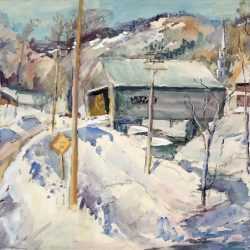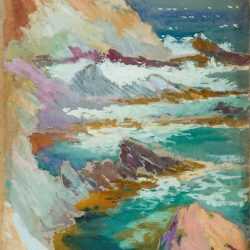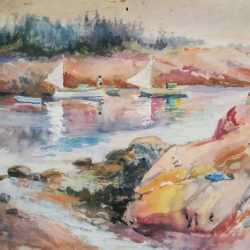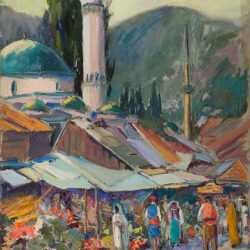Filter by Type
Filter by Category
Filter by Size
Filter by Year

Gertrude Beals Bourne
American (1868-1962)
Gertrude Beals Bourne, American (1868-1962)
Gertrude Beals grew up on Dartmouth Street in the Back Bay of Boston. In the late 1880’s, she began to study art privately first with Henry Rice, 1853-1934 (who had learned his craft from Ross Turner, 1847-1915) and later with Henry B. Snell (1858-1943), one of the founding members of the New York Watercolor Club. An important part of her education was the trips she took to Europe with her family in the 1890’s when she painted in France, Norway, and Great Britain. In 1892, Gertrude Beals first exhibited at the Boston Art Club along with fellow artists Helen Knowlton and Marie Danforth Page. Her realism in works from the 1890’s allies her stylistically with the American landscape tradition exemplified by Winslow Homer and Childe Hassam, both of whom exhibited paintings during the 1890’s at the Boston Art Club where Bourne frequently exhibited through 1905.
Gertrude Beals married the architect Frank Augustus Bourne in 1904 and moved into “Sunflower Castle” at 130 Mount Vernon Street on Beacon Hill. There they became part of a community of artists and helped to re-gentrify the Hill in the first decades of the 20th century. Bourne was also very aware of the work of John Singer Sargent, Maurice Prendergast and Arthur Wesley Dow. The Museum of Fine Arts, Boston Museum of Fine Arts acquired several of Sargent’s watercolors in 1912, and it is known that Bourne studied his watercolor style at length and copied some of his works as an academic exercise. Both Maurice Prendergast and his brother Charles were neighbors on Mount Vernon Street and became close friends. From 1917-19 the Bournes rented a summer residence in Ipswich, Massachusetts from Arthur Wesley Dow.
Bourne continued to exhibit nationally as well as locally through the age of seventy-five. Outside of the Boston area, she participated in exhibitions at the Corcoran Gallery, the Art Institute of Chicago, the Baltimore Watercolor Club, the Brooklyn Museum, James Newman Galleries, London, and the Pennsylvania Academy of Fine Arts. Her work is included at the National Museum of American Art, the Corcoran Gallery, the Boston Museum of Fine Arts, the Brockton Art Museum, the Currier Gallery of Art, the Peabody- Essex Museum, and the Danforth Museum of Art.
The most comprehensive source for her biographical information is:
"Gertrude Beals Bourne: Artist in Brahmin Boston" 2004 Boston Copley Square Press 2004 1st Edition. Oblong Quarto. Hard and Soft Cover 144pp 104 color and 9 black and white illustrations; Foreword by Patricia Hills; (Chronology); (Bibliography); (Index). Available from Childs Gallery.
The story of elegant Bostonians has been told many times, notably by John Marquand in The Late George Apley and Cleveland Amory in The Proper Bostonians. Now D. Roger Howlett writes about Boston Brahmin painter Gertrude Beals Bourne (1868-1962). Lavishly illustrated with color reproductions of her beautiful Impressionist watercolors of still life, seascapes, and paintings of flowers and gardens, the book chronicles the artist's life, times, and artistic style.
Born on Beacon Hill, Bourne grew up in the Back Bay and New York and began her career as a painter in the 1890s. In 1904 she married the architect Frank A. Bourne, and the couple moved to 130 Mount Vernon Street—known as "Sunflower Castle." Frank helped to found the Beacon Hill Association, Gertrude founded the Beacon Hill Garden Club, and the couple is credited with re-gentrifying Beacon Hill in the first two decades of the twentieth century. Among their friends were artists Laura Coombs Hills, Maurice Prendergast, his brother Charles Prendergast, and landscape architect Frederick Law Olmsted, Jr. After Frank A. Bourne died in 1936, Gertrude continued to paint and exhibit until shortly before her death in 1962. Her work was shown at such venues as the Boston Art Club, the New York Watercolor Club, the American Watercolor Society, the Art Institute of Chicago, the Corcoran Gallery of Art, and the National Gallery of Art.
This long over-due portrait of a significant American Impressionist painter will appeal to art historians and collectors, as well as those interested in Boston history.
About the Author
D. ROGER HOWLETT is President of the Childs Gallery. He is the author of William Partridge Burpee: American Marine Impressionist, also distributed by Northeastern University Press. He lives in Boston. PATRICIA HILLS is Professor of Art History at Boston University.





![Watercolor by Gertrude Beals Bourne: [High Street, Ipswich, Massachusetts], available at Childs Gallery, Boston](https://childsgallery.com/wp-content/uploads/gertrude-beals-bourne_high-street-ipswich-massachusetts_89-9-29_childs_gallery_48413-250x250.jpg)
![Watercolor by Gertrude Beals Bourne: [Market], available at Childs Gallery, Boston](https://childsgallery.com/wp-content/uploads/gertrude-beals-bourne_market_89-9-125_childs_gallery_47848-250x250.jpg)
![Watercolor by Gertrude Beals Bourne: [Red Poppies], available at Childs Gallery, Boston](https://childsgallery.com/wp-content/uploads/gertrude-beals-bourne_red-poppies_89-9-81_childs_gallery_47846-250x250.jpg)
![Watercolor by Gertrude Beals Bourne: [Apple Blossoms], available at Childs Gallery, Boston](https://childsgallery.com/wp-content/uploads/gertrude-beals-bourne_apple-blossoms_89-9-127_childs_gallery_47844-250x250.jpg)
![Watercolor by Gertrude Beals Bourne: [Sir Harry the Cockatoo in the Garden at 130 Mount Vernon Street], available at Childs Gallery, Boston](https://childsgallery.com/wp-content/uploads/gertrude-beals-bourne_sir-harry-the-cockatoo-in-the-garden-at-130-mount-vernon-street_89-9-221_childs_gallery-250x250.jpg)









![Watercolor by Gertrude Beals Bourne: Mt. Washington, Winter [New Hampshire], available at Childs Gallery, Boston](https://childsgallery.com/wp-content/uploads/gertrude-beals-bourne_mt.-washington-winter-new-hampshire_childs_gallery-250x250.jpg)



![Watercolor by Gertrude Beals Bourne: [Marshes, Ipswich], available at Childs Gallery, Boston](https://childsgallery.com/wp-content/uploads/gertrude-beals-bourne_marshes-ipswich_childs_gallery_13749-250x250.jpg)
![Watercolor By Gertrude Beals Bourne: [cactus Flowers] At Childs Gallery](https://childsgallery.com/wp-content/uploads/gertrude_beals_bourne_cactus_flowers_89-9-192_childs_gallery-250x250.jpg)
![Watercolor by Gertrude Beals Bourne: [M.I.T. at Sunset], represented by Childs Gallery](https://childsgallery.com/wp-content/uploads/gertrude_beals_bourne__m.i.t._at_sunset__89-9-199_childs_gallery-250x250.jpg)










